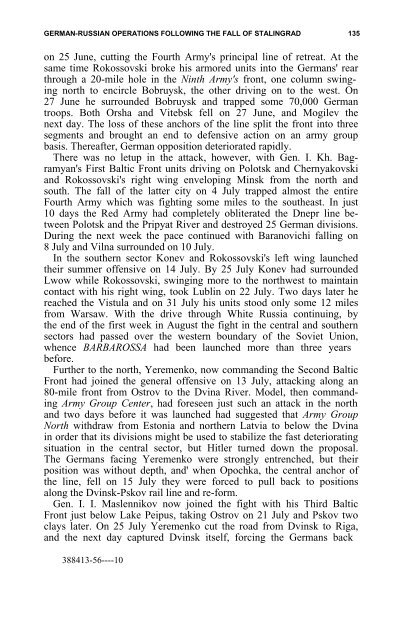the soviet partisan movement 1941-1944 by edgar m. howell
the soviet partisan movement 1941-1944 by edgar m. howell
the soviet partisan movement 1941-1944 by edgar m. howell
You also want an ePaper? Increase the reach of your titles
YUMPU automatically turns print PDFs into web optimized ePapers that Google loves.
GERMAN-RUSSIAN OPERATIONS FOLLOWING THE FALL OF STALINGRAD<br />
135<br />
on 25 June, cutting <strong>the</strong> Fourth Army's principal line of retreat. At <strong>the</strong><br />
same time Rokossovski broke his armored units into <strong>the</strong> Germans' rear<br />
through a 20-mile hole in <strong>the</strong> Ninth Army's front, one column swinging<br />
north to encircle Bobruysk, <strong>the</strong> o<strong>the</strong>r driving on to <strong>the</strong> west. On<br />
27 June he surrounded Bobruysk and trapped some 70,000 German<br />
troops. Both Orsha and Vitebsk fell on 27 June, and Mogilev <strong>the</strong><br />
next day. The loss of <strong>the</strong>se anchors of <strong>the</strong> line split <strong>the</strong> front into three<br />
segments and brought an end to defensive action on an army group<br />
basis. Thereafter, German opposition deteriorated rapidly.<br />
There was no letup in <strong>the</strong> attack, however, with Gen. I. Kh. Bagramyan's<br />
First Baltic Front units driving on Polotsk and Chernyakovski<br />
and Rokossovski's right wing enveloping Minsk from <strong>the</strong> north and<br />
south. The fall of <strong>the</strong> latter city on 4 July trapped almost <strong>the</strong> entire<br />
Fourth Army which was fighting some miles to <strong>the</strong> sou<strong>the</strong>ast. In just<br />
10 days <strong>the</strong> Red Army had completely obliterated <strong>the</strong> Dnepr line between<br />
Polotsk and <strong>the</strong> Pripyat River and destroyed 25 German divisions.<br />
During <strong>the</strong> next week <strong>the</strong> pace continued with Baranovichi falling on<br />
8 July and Vilna surrounded on 10 July.<br />
In <strong>the</strong> sou<strong>the</strong>rn sector Konev and Rokossovski's left wing launched<br />
<strong>the</strong>ir summer offensive on 14 July. By 25 July Konev had surrounded<br />
Lwow while Rokossovski, swinging more to <strong>the</strong> northwest to maintain<br />
contact with his right wing, took Lublin on 22 July. Two days later he<br />
reached <strong>the</strong> Vistula and on 31 July his units stood only some 12 miles<br />
from Warsaw. With <strong>the</strong> drive through White Russia continuing, <strong>by</strong><br />
<strong>the</strong> end of <strong>the</strong> first week in August <strong>the</strong> fight in <strong>the</strong> central and sou<strong>the</strong>rn<br />
sectors had passed over <strong>the</strong> western boundary of <strong>the</strong> Soviet Union,<br />
whence BARBAROSSA had been launched more than three years<br />
before.<br />
Fur<strong>the</strong>r to <strong>the</strong> north, Yeremenko, now commanding <strong>the</strong> Second Baltic<br />
Front had joined <strong>the</strong> general offensive on 13 July, attacking along an<br />
80-mile front from Ostrov to <strong>the</strong> Dvina River. Model, <strong>the</strong>n commanding<br />
Army Group Center, had foreseen just such an attack in <strong>the</strong> north<br />
and two days before it was launched had suggested that Army Group<br />
North withdraw from Estonia and nor<strong>the</strong>rn Latvia to below <strong>the</strong> Dvina<br />
in order that its divisions might be used to stabilize <strong>the</strong> fast deteriorating<br />
situation in <strong>the</strong> central sector, but Hitler turned down <strong>the</strong> proposal.<br />
The Germans facing Yeremenko were strongly entrenched, but <strong>the</strong>ir<br />
position was without depth, and' when Opochka, <strong>the</strong> central anchor of<br />
<strong>the</strong> line, fell on 15 July <strong>the</strong>y were forced to pull back to positions<br />
along <strong>the</strong> Dvinsk-Pskov rail line and re-form.<br />
Gen. I. I. Maslennikov now joined <strong>the</strong> fight with his Third Baltic<br />
Front just below Lake Peipus, taking Ostrov on 21 July and Pskov two<br />
clays later. On 25 July Yeremenko cut <strong>the</strong> road from Dvinsk to Riga,<br />
and <strong>the</strong> next day captured Dvinsk itself, forcing <strong>the</strong> Germans back<br />
388413-56----10
















